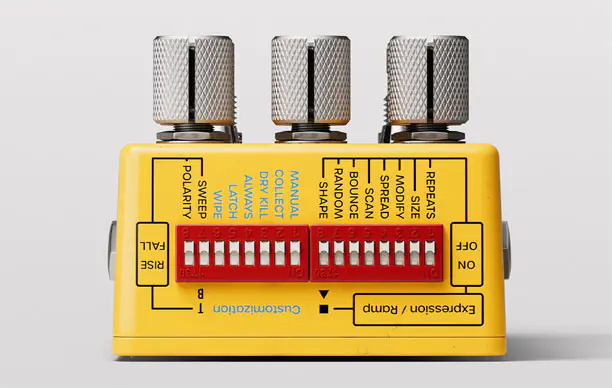
The Chase Bliss Audio Habit is a new, playful/experimental multi-mode echo/looper pedal. If it is as fun as it looks, it’s bound to make a lot of creative guitarists happy.
On March 28, company owner and effect designer Joel Korte had been teasing this release with this post on Instagram:
“Got some news. I know we’ve been quiet with pedal releases and such since we put out CXM 1978 with Meris in 2020… but that doesn’t mean we haven’t been working as hard as ever on some things in the background during that time. This week we’ll finally be able to unveil some stuff that has taken two years to get right. We can’t wait!”
The pedal is now officially out and has the classic Chase Bliss compact series layout featuring 6 knobs, 4 toggle switches, and two footswitches, plus the signature 12 DIP switches on the back panel opening up a world of tweakability, here’s a detail of it.

The Ins/Outs also reflect the configuration of the company’s latest pedals – it appears to be a mono pedal with a Tap Tempo/Midi out and an Exp/CV In. However, it sports graphics that are a lot more playful than any other CBA pedal.
What’s different about the Habit is that it has an always active 3-minute memory, which is why is dubbed as an “echo collector”:
It stores everything you play for later, so you can revisit and reuse sounds from the past: Gather up loops, design echo patterns, and harmonize with yourself from two minutes ago.
The pedal can just be used as a simple echo (one with up to 60 seconds of delay!), but whenever it’s on it records every sound that enters it and, at any moment, the player can scan this memory and replay what was live just a few moments ago. This recorded material can then be edited into rhythmic patterns, and then fed back into the echo effect, which can be shaped through two banks of modifiers.
You can build loops by navigating the memory, picking out and combining various moments from the past. Or set the memory to overdub so that long-form songs emerge just by playing into it. You can even send the output audio right back into the input in Feed mode to record your live effects processing and knob changes to memory.
As usual with the Chase Bliss pedals, there’s a lot more to this device than we have space here to tackle. Here are the launch videos, the first one, by Canadian artsy YouTuber Knobs, will give you an idea of the creative potential of this stompbox.
We added the Chase Bliss Audio Habit to our article about the best psychedelic and experimental delays.
[Wanna get this baby and be supportive? Buy it through our Reverb affiliate program – at no extra cost.
Chase Bliss Audio Habit, Builder’s Notes
Musical sketchpad. Compositional delay.
Habit is a delay with a memory. It stores everything you play for later, so you can revisit and reuse sounds from the past: Gather up loops, design echo patterns, and harmonize with yourself from two minutes ago.It’s an effect that can be turned into an instrument on a whim, an evolving paint-splatter of everything you do. Or it could just be a fun echo.
• Use Habit’s interconnected machinery to design new rhythms and patterns.
• Shape your echoes with two banks of modifiers.
• Scan freely through the memory, or let Habit do it for you.
• Collect free-form compositions by simply playing into the pedal.Scanning.
Moments from the past.
Habit’s secret is a digital tape reel that records every sound that enters the pedal. As long as Habit is on, it’s recording.At any moment, you can scan back into this history and play moments from the past–instead of, or alongside the present. This architecture makes a pile of interesting things possible: never-before-heard delays, bizarre loops and transitions, and even entire songs captured right inside the pedal.
60-second delay
We’ve tossed a whole lot of echo into Habit. Frippertronics, loop generation, and the ability to create glacially evolving scenes–a sampling of what you can get up to with all that delay.Secondary echoes
Turn up the Spread control to listen to two moments at once. This is the key to Habit’s multi-tap abilities, but can also get into some wild cognitive dissonance. Echoes of the past and present, playing side-by-side.Modifiers
Trim, filter and etc. your echoes into any shape you wish with Habit’s flexible modifiers.+ Tape delay
+ Dissolving echoes
+ Shrinking subdivisions
+ More more moreCollecting.
A new kind of workflow.
Habit’s compositional side introduces a new kind of workflow, like a free-form sampler. You can build loops by navigating the memory, picking out and combining various moments from the past. Or set the memory to overdub so that long-form songs emerge just by playing into it.You can even send the output audio right back into the input in Feed mode to record your live effects processing and knob changes to memory.
Expand and integrate
Habit features advanced connectivity and customization options including MIDI, CV and Expression control, sync, presets, and internal modulation of any or all its knobs.






















